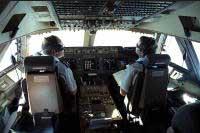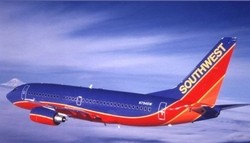"I'm Not Dead Yet"
 The Iraq war and 9/11 have passengers skittish.
Severe acute respiratory syndrome (SARS) is hurting travel to Asia.
The Bush administration isn't in of a mind to be giving corporate
handouts just now.
The Iraq war and 9/11 have passengers skittish.
Severe acute respiratory syndrome (SARS) is hurting travel to Asia.
The Bush administration isn't in of a mind to be giving corporate
handouts just now.
It hardly seems that anything else could go wrong for the US
airline industry. Yet, in less than a week, airline executives have
a lot less reason to be gloomy. There's even an emerging sense that
most, if not all, of the major US carriers may survive the
industry's ongoing crisis, albeit in a weakened financial
condition.
Prozac, Anyone?
 What's behind the sudden mood swing?
What's behind the sudden mood swing?
US Airways Group emerged from bankruptcy protection last week.
American Airlines reached dramatic cost-cutting deals with its
unions, averting an imminent bankruptcy filing. And on Friday,
United Airlines reached a six-year, $1.8 billion concession package
with its flight attendants' union, adding to the six-year, $6.6
billion in concessions agreed to by its pilots' union in late
March.
All of that is good news for consumers because more airlines
criss-crossing the skies means lower fares. But it won't solve what
many experts say is the biggest problem facing airlines and their
shareholders: too many seats chasing too few passengers.
 Ever since United sought Chapter 11 protection in
December, many of its competitors have argued the solution to the
industry's woes is for United, the nation's second-largest carrier,
to go away.Gordon Bethune, chief executive of Continental Airlines
Inc., has been one of the loudest proponents of a United
liquidation. Last week, he renewed his call for a smaller
industry.
Ever since United sought Chapter 11 protection in
December, many of its competitors have argued the solution to the
industry's woes is for United, the nation's second-largest carrier,
to go away.Gordon Bethune, chief executive of Continental Airlines
Inc., has been one of the loudest proponents of a United
liquidation. Last week, he renewed his call for a smaller
industry.
A 15 percent reduction in capacity would be about right, Bethune
told CNBC Wednesday. "That would be one less airline," he said, not
naming any names. The folks at United knew whom he was talking
about anyway. United has a 17 percent market share.
Now some experts are suggesting the answer to the industry's
problems may take a less radical form. While conceding the need for
consolidation, Jurgen Weber, the outgoing chairman of German
carrier Lufthansa, says, "You can do it in two ways. You can reduce
the number of airlines or you can reduce the capacity within
each."
Door Number Two, Please, Monty
 The
second option is better by far, he says, because putting a major
carrier out of business likely would leave one or more major hubs
deserted and certain parts of the country underserved by
carriers.
The
second option is better by far, he says, because putting a major
carrier out of business likely would leave one or more major hubs
deserted and certain parts of the country underserved by
carriers.
Aviation consultant Michael Boyd agrees: "It's absolutely better
if they all survive. We need as many carriers as possible. If
United goes away, there will be markets with much less service or
no service at all."
Getting smaller is something the nation's airlines have become
adept at. Before Sept. 11, American and TWA, which it acquired in
April 2001, offered a combined 3,300 daily departures. Today, the
airline flies 700 fewer flights a day, a 21 percent reduction.
In the same time frame, United has cut its daily departures 34
percent, to 1,574 from 2,400. The bottom-line: Customers no longer
have the same amount of choices they once did. And many second-tier
cities are now served by regional jets. The tradeoff: Airfares are
really low, and there's less congestion at some major airports.
The Shape Of Things To Come
 Several experts and economists say it's too soon
to predict the shape of the airline industry after it flies through
the current crisis. But all this pain may end up being a good
thing, says Carl Tannenbaum, chief economist with Chicago's LaSalle
Bank.
Several experts and economists say it's too soon
to predict the shape of the airline industry after it flies through
the current crisis. But all this pain may end up being a good
thing, says Carl Tannenbaum, chief economist with Chicago's LaSalle
Bank.
"It's easy to be an armchair quarterback when you don't work for
an airline or own an airline," Tannenbaum says, "but the hope is
the airline industry we will have two years from now will be more
to the satisfaction of the groups that depend on it."
Airlines are restructuring their routes. Outdated work rules
accrued over decades are being dropped from contracts, and airline
executives are fiendish about cost-cutting, he notes. "There have
been many times in the past 20 years that it looked very dire for
the economy as a whole or particular industries," Tannenbaum said.
"But one thing that has always impressed me is that American
companies are very resilient and adaptable. We are able to go
through transitions so our corporations, workers and operations
remain as efficient as possible."
The alternative--protecting industries from change--means ending
up like Japan, dragging its banking crisis out over decades, he
says. Others aren't nearly so optimistic about the outcome. They
say everything hangs in the balance, and much of it depends on how
a war is going halfway around the world.
"If you believe that this war is over by the end of the week,
then the conclusion is that United doesn't liquidate and American
doesn't go into Chapter 11," says John Pincavage, a Westport,
Conn.-based financial adviser to airlines.
It's All A Matter Of Timing
 "But if this thing goes on for four weeks, you
come to a completely different conclusion. Or if an aircraft gets
shot down by a missile. Or if the SARS panic spreads. There are
five or six things the airlines have no control over that, if
continued for an extended period, keep scaring away traffic."
"But if this thing goes on for four weeks, you
come to a completely different conclusion. Or if an aircraft gets
shot down by a missile. Or if the SARS panic spreads. There are
five or six things the airlines have no control over that, if
continued for an extended period, keep scaring away traffic."
One thing airlines do have some control over is their labor
costs, and these days it's a race to the bottom. US Airways, which
had the industry's highest costs for much of the 1990s, won wage
concessions from its unions during its bankruptcy proceedings. It
now projects its 2003 cost per available seat-mile, excluding fuel,
at 10.5 cents, 14 percent lower than before its Chapter 11 filing
last August.
American Airlines reduced its costs, including fuel, by 2.6
percent last year to 10.8 cents per seat-mile. It reshuffled
flights at hubs in Chicago and Dallas to spread them more evenly
throughout the day, and it automated customer check-in. Total
savings: $2 billion. Now American has tentative deals to reduce
labor expenses by almost another $2 billion. Its long-term goal:
get its costs down to within 30 percent of Southwest's.
United, where costs soared in the past several years, is
shooting for "best in class" costs, according to Chief Executive
Glenn Tilton. Translation: in the ballpark with Southwest.
There's a long way to go. Southwest's cost per seat-mile last
year, including fuel, was 7.4 cents. United's was 11.3 cents, a 35
percent difference.
Still, if United succeeds in winning the $2.56 billion in labor
savings from its unions as well as $1.8 billion in non-labor
savings, its overall costs would drop by more than 25 percent. Not
all of the non-labor costs would translate into lower seat-mile
costs, but some would.
If the labor savings and half the non-labor savings were in
place last year, United's costs would have been 19 percent lower,
or 9.2 cents per seat-mile, a big step in the right direction.
But You Can Only Cut So Much
 While the industry will undoubtedly emerge leaner
and meaner, some experts warn that getting costs down isn't enough
to ensure long-term success. United and other mainline carriers
will always have higher structural costs than discount carriers
because they operate from more expensive hub airports and have more
complex fleets. So they have to offer customers a better
experience, whether that means in-flight meals, advance seat
reservations or first-class upgrades.
While the industry will undoubtedly emerge leaner
and meaner, some experts warn that getting costs down isn't enough
to ensure long-term success. United and other mainline carriers
will always have higher structural costs than discount carriers
because they operate from more expensive hub airports and have more
complex fleets. So they have to offer customers a better
experience, whether that means in-flight meals, advance seat
reservations or first-class upgrades.
Financial adviser Pincavage worries that in their efforts to cut
costs, mainline carriers have gutted their service advantages as
well. "Why do I want to fly these guys if price has become the only
determinant of selection," he wonders. "Airlines are doing the
obvious stuff from a tactical standpoint, but I don't see any of
them doing something from a strategic sense. I don't see those kind
of decisions being made. "Why not go back to brand-building?"
 Klyde Morris (10.27.25)
Klyde Morris (10.27.25) Airborne 10.27.25: MOSAIC Phase 1, Katana Returns, MOSAIC Town Hall!
Airborne 10.27.25: MOSAIC Phase 1, Katana Returns, MOSAIC Town Hall! Airborne-NextGen 10.28.25: Police Drones, Nat'l Parks v UAVs, MOSAIC Phase 1
Airborne-NextGen 10.28.25: Police Drones, Nat'l Parks v UAVs, MOSAIC Phase 1 ANN FAQ: Follow Us On Instagram!
ANN FAQ: Follow Us On Instagram! NTSB Final Report: Airbus A321-271N (A1); Cessna 172N (A2)
NTSB Final Report: Airbus A321-271N (A1); Cessna 172N (A2)









